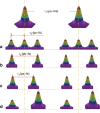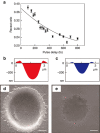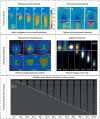Electrons dynamics control by shaping femtosecond laser pulses in micro/nanofabrication: modeling, method, measurement and application
- PMID: 30839523
- PMCID: PMC6060063
- DOI: 10.1038/lsa.2017.134
Electrons dynamics control by shaping femtosecond laser pulses in micro/nanofabrication: modeling, method, measurement and application
Abstract
During femtosecond laser fabrication, photons are mainly absorbed by electrons, and the subsequent energy transfer from electrons to ions is of picosecond order. Hence, lattice motion is negligible within the femtosecond pulse duration, whereas femtosecond photon-electron interactions dominate the entire fabrication process. Therefore, femtosecond laser fabrication must be improved by controlling localized transient electron dynamics, which poses a challenge for measuring and controlling at the electron level during fabrication processes. Pump-probe spectroscopy presents a viable solution, which can be used to observe electron dynamics during a chemical reaction. In fact, femtosecond pulse durations are shorter than many physical/chemical characteristic times, which permits manipulating, adjusting, or interfering with electron dynamics. Hence, we proposed to control localized transient electron dynamics by temporally or spatially shaping femtosecond pulses, and further to modify localized transient materials properties, and then to adjust material phase change, and eventually to implement a novel fabrication method. This review covers our progresses over the past decade regarding electrons dynamics control (EDC) by shaping femtosecond laser pulses in micro/nanomanufacturing: (1) Theoretical models were developed to prove EDC feasibility and reveal its mechanisms; (2) on the basis of the theoretical predictions, many experiments are conducted to validate our EDC-based femtosecond laser fabrication method. Seven examples are reported, which proves that the proposed method can significantly improve fabrication precision, quality, throughput and repeatability and effectively control micro/nanoscale structures; (3) a multiscale measurement system was proposed and developed to study the fundamentals of EDC from the femtosecond scale to the nanosecond scale and to the millisecond scale; and (4) As an example of practical applications, our method was employed to fabricate some key structures in one of the 16 Chinese National S&T Major Projects, for which electron dynamics were measured using our multiscale measurement system.
Keywords: electrons dynamics control; femtosecond laser; micro/nano fabrication; pulse shaping.
Conflict of interest statement
The authors declare no conflict of interest.
Figures
























References
-
- Sugioka K, Cheng Y. Ultrafast lasers—reliable tools for advanced materials processing. Light Sci Appl 2014; 3: e149 doi:10.1038/lsa.2014.30..
-
- Gamaly EG. Femtosecond Laser-Matter Interaction: Theory, Experiments and Applications. Boca Raton: CRC Press; 2011.
-
- Levis RJ, Menkir GM, Rabitz H. Selective bond dissociation and rearrangement with optimally tailored, strong-field laser pulses. Science 2001; 292: 709–713. - PubMed
-
- Rezaei S, Li JZ, Herman PR. Burst train generator of high energy femtosecond laser pulses for driving heat accumulation effect during micromachining. Opt Lett 2015; 40: 2064–2067. - PubMed
Publication types
LinkOut - more resources
Full Text Sources
Research Materials
Miscellaneous

